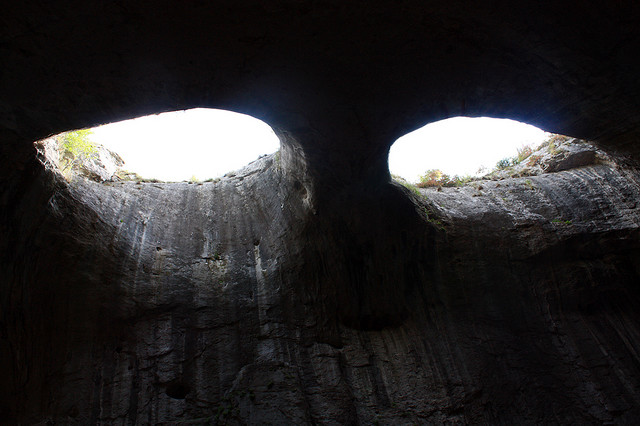Left: Prohodna Peshtera. Right: Peshtera Kontrabas (Double Bass)
Bulgaria, I.2014
I am hanging on a rope around 40 meters above the rocky bottom of Prohodna. I am not sliding down, but am being slowly lowered, entirely dependent on Hristo and Dayana who are gradually putting me down towards the bottom of the cave. I insisted on being able to photograph on the way, which now seems not such a good idea - one has always this illusive feeling of control of the situation, when he's holding the device in his own hands.
When I'm looking down - through the lens or with naked eye - I realise why Karlukovo is said to attract madmen. Not only because the mental institution located here, but also (or mainly?) because of the caves. It is one of the regions of Bulgaria, that are most "pierced" with holes, over 300 caves of different sizes, from 30-40cm to 50m of height. But in this moment I am thinking mainly about getting my feet safely on the rocky bottom of the cave and not to drop this damn camera in the meantime. The descent stops for several seconds, I don't know why they stopped to lower me, the treaky imagination whispers the darkest scenarios into my ear. I try to flippantly swing my legs to gain some courage and make an attempt to reach the radio, find out what problems do they have up there...
My imagination is running fast, enhanced by the surreal surroundings - the walls covered with rotten-green, rusty-brown and moldy-blue colours. The rocks, which have seen and remember many things. And many people, of which the treacherous human memory has already forgotten.
Euphoric joy and relief come, when at last I land safely on the ground and untie the rope. Lowered down through one of the "Eyes of God" all the doubts stated above - literally - go away..
The Eyes of God - Prohodna Peshtera. Photo: Wiki Commons
The grerat number in the Karlukovo region comes with the great number of more or less real stories and legends. In some silent nights from the last houses of the village a horrendous dog yelp can be heard, made by animals that were thrown into the Dog Cave (Kucheshkata Dupka). The creature driven mad by hunger and darkness whimper for help, finally fighting with themselves for the meat still sticking to the one of "the other one". How much truth is in these stories - cannot tell, but one of the speleologists states that one time he has found a dog in the Dog Cave, blinded from eternal darkness, which he's taken home with himself. Others say, that they've found suspiciously high amount of animal bones... with marks of teeth used in this fractricidal fight for survival.
That's a one more mark made by the madness in Karlukovo region - I think to myself, closing the window in "Peshteren Dom" shelter. With a view on the mental institution on the other side of Iskar River. In the past years there were noted several escapes from the hospital, and caves surrounding it gave a perfect shelter to the patients. One of them is said to even get back to society, trying to find work and start a normal life. But after few months he concluded that "oh no, I am not that mad" and returned back to the clinic...








